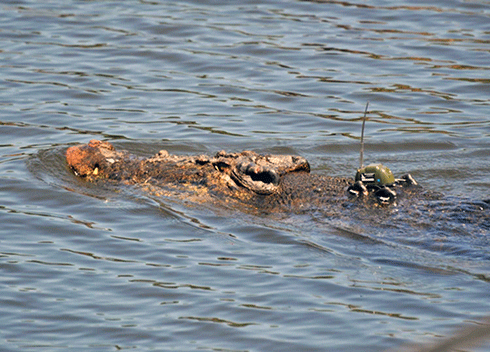
|
Published: 19 May 2014
Cheaper e-tags enable tracking of more Australian animals
At a recent national workshop, scientists described how the increased use of smaller and cheaper electronic tags (e-tags) is enabling them to document, in unprecedented detail, the secret life of Australian fauna.

|
|
The researchers are using e-tags to track the movements of saltwater crocodiles in northern waterways. Credit:
University of Queensland
|
The national tagging effort includes cassowaries, shearwaters, koalas, dingos, feral cats, bats, lungfish, bees, whale sharks, camels, saltwater crocodiles, freshwater and sea turtles and many more animals, both native and introduced.
This bank of information is allowing researchers to better manage and conserve animals in the wild, say Dr Hamish Campbell and Dr Ross Dwyer of the Australian Centre for Ecological Analysis and Synthesis (ACEAS) Working Group for advancing the application of animal telemetry data in ecosystem management.
At the recent ACEAS Grand Workshop in Canberra, Dr Campbell of The University of New England and Dr Dwyer of The University of Queensland discussed how Australia can compile, share and re-use tracking data to improve monitoring techniques, both to benefit the animals and drive scarce conservation dollars further.
‘Advanced technology has given us smaller, lighter and cheaper electronic tags, which allow us to track more animals at more locations, over longer time periods and at more of their life stages,’ said Dr Dwyer.
‘For instance, we can now follow the foraging and migratory movements of birds and bats, or even attach tiny radio tags to small flying insects such as bees and dragonflies.’
The researchers say their group is currently tracking fish, sharks and rays in the ocean, and saltwater crocodiles in waterways throughout Queensland.
‘We use a combination of acoustic tags and underwater hydrophones to follow these animals through long stretches of rivers, estuaries, reefs and coasts over many years,’ said Dr Campbell.
He says that with tens of thousands animals tagged, it’s crucial that the results are accessible to everyone. ‘Between 2000 and 2013 alone, 12,000 individual animals were tracked, amassing more than 81,000 tracking days.
‘However, only half of the discoveries have been revealed, and unpublished findings remain inaccessible. This means we risk wasting funds on work that has been done already, as well as stressing the animals unnecessarily.’
To avoid these problems, Dr Dwyer and Dr Campbell are part of a team creating a national online database that enables visitors to access all the tracking studies carried out on any recorded species.
Source: ACEAS/University of Queensland



